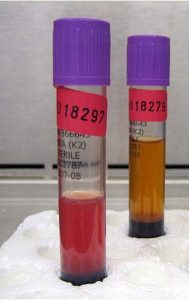Ron Hines DVM PhD
The D- Dimer Test
When blood clots (thrombi) that have formed anywhere in your dog or cat’s body begin to dissolve, they liberate a compound called D-dimer. That is because those clots contain fibrin and when fibrin dissolves (fibrinolysis) D-dimer fragments are released.
Besides confirming the presence of blood clots, D-dimer blood levels can also increase in life-threatening clotting defects that sometimes accompany shock and trauma. That situation is called disseminated intravascular coagulation (DIC).
The d-dimer test is only one of a group of tests that investigate the state of your pet’s blood clotting mechanism. Your veterinarian might include it if he/she is suspicious that your pet is bleeding internally (or excessively through an unseen wound) due to a fault in its blood clotting mechanism. Because the clotting of blood is such a complex process (the coagulation cascade) with many different stages or steps and the interplay of many different body chemicals and cells; a series of tests might be required to determine exactly what is wrong. The other tests used include a thrombocyte count, prothrombin time (PT), partial thromboplastin time (PTT), fibrinogen level and thrombin clot time TCT.
Reasons Why Your Dog Or Cat’s D-dimer Blood Levels Might Be High:
A disseminated intravascular coagulation crisis (DIC), blood clots, severe trauma, after extensive surgery, cancer, internal hemorrhage, anaphylactic shock. Perhaps after a vaccination reaction or a bee sting, liver disease, lung embolisms (perhaps associated with heartworms) and occasionally in widespread inflammatory disease such as FIP in cats
Complementary Tests:
Prothrombin time (PT), aPTT, CBC / WBC and blood chemistry panel
DxMe
You are on the Vetspace animal health website
Visiting the products that you see displayed on this website help pay the cost of keeping these articles on the Internet.
